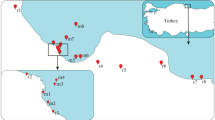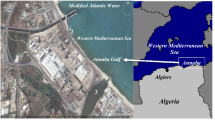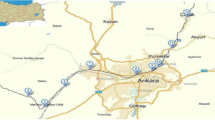Abstract
This study focused on evaluation of the levels, seasonal variations and human health risks associated with polychlorinated naphthalenes (PCNs) in water and sediment samples of Markman Canal using solid phase and soxhlet extraction methods respectively, followed by clean-up and quantification with gas chromatograph coupled with microelectron capture detector. The sum of eight PCNs congener’s (∑8PCNs) in water and sediments varied from 0.035 to 0.699 μg/L and 0.260 to 6744.16 μg/kg dw, respectively. Highest PCNs concentrations were recorded in water during winter, while sediment samples collected during spring contained maximum levels. The estimated toxic equivalency (TEQ) for water and sediments was 1.19 × 10–7–1.47 × 10–4 µg/L and 4.43 × 10−5–4.19 × 10−1 µg/kg consecutively. The PCN levels and TEQ values revealed that this waterbody is polluted but constitutes no excess health risk. Efforts should be made to control all the activities contributing to pollution of this canal.





Similar content being viewed by others
References
Abou Anni, I. S., Bianchini, A., Barcarolli, I. F., Varela, A. S., Robaldo, R. B., Tesser, M. B., & Sampaio, L. A. (2016). Salinity influence on growth, osmoregulation and energy turnover in juvenile pompano Trachinotus marginatus Cuvier 1832. Aquaculture, 455, 63–72. https://doi.org/10.1016/j.aquaculture.2016.01.010
Adams, J. B., Pretorius, L., & Snow, G. C. (2019). Deterioration in the water quality of an urbanised estuary with recommendations for improvement. Water SA, 45(1), 86. https://doi.org/10.4314/wsa.v45i1.10
Agunbiade, I. V., Adeniji, A. O., Okoh, A. I., & Okoh, O. O. (2020). A review on occurrence and analytical procedures for the evaluation of polychlorinated naphthalenes in human and environmental matrices. Environmental Pollutants and Bioavailability, 32(1), 154–174. https://doi.org/10.1080/26395940.2020.1829992
Al Dahaan, S. A. M., Al-Ansari, N., & Knutsson, S. (2016). Influence of groundwater hypothetical salts on electrical conductivity total dissolved solids. Engineering, 8, 823–830. https://doi.org/10.4236/eng.2016.811074
Alharbi, O. M. L., Basheer, A. A., Khattab, R. A., & Ali, I. (2018). Health and environmental effects of persistent organic pollutants. Journal of Molecular Liquid, 263, 442–453. https://doi.org/10.1016/j.molliq.2018.05.029
Archer, E., Landman, W., Malherbe, J., Tadross, M., & Pretorius, S. (2019). South Africa’s winter rainfall region drought: A region in transition? Climate Risk Management, 25, 100188. https://doi.org/10.1016/j.crm.2019.100188
Ashraf, M. A. (2017). Persistent organic pollutants (POPs): A global issue, a global challenge. Environmental Science and Pollution Research, 24, 4223–4227. https://doi.org/10.1007/s11356-015-5225-9
Awe, A. A., Opeolu, B. O., Olatunji, O. S., Fatoki, O. S., Jackson, V. A., & Snyman, R. G. (2020). Occurrence of PAHs in water samples of the Diep River, South Africa. Water SA, 46(1), 80–93. https://doi.org/10.17159/wsa/2020.v46.i1.7888
Babalola, B. A., & Adeyi, A. A. (2018). Levels, dietary intake and risk of polybrominated diphenyl ethers (PBDEs) in foods commonly consumed in Nigeria. Food Chemistry, 265, 78–84. https://doi.org/10.1016/j.foodchem.2018.05.073
Brack, W., Kind, T., Schrader, S., Möder, M., & Schüürmann, G. (2003). Polychlorinated naphthalenes in sediments from the Industrial region of Bitterfeld. Environmental Pollution, 121, 81–85. https://doi.org/10.1016/s0269-7491(02)00200-2
Cappelletti, N., Astoviza, M., Morrone, M., & Tatone, L. (2019). Urban geochemistry and potential human health risks in the Metropolitan Area of Buenos Aires: PAHs and PCBs in soil, street dust, and bulk deposition. Environmental Geochemistry and Health, 41, 699–713. https://doi.org/10.1007/s10653-018-0163-3
Carr, G.M., Neary, J.P. (2008). Water Quality for Ecosystem and Human Health. United Nations Environment Programme Global Environment Monitoring System, Water Programme. Accessed on: 29/01/2021. Available online: https://www.cbd.int/doc/health/health-waterquality-en.pdf
Castells, P., Parera, J., Santos, F. J., & Galceran, M. T. (2008). Occurrence of polychlorinated naphthalenes, polychlorinated biphenyls and short-chain chlorinated paraffins in marine sediments from Barcelona (Spain). Chemosphere, 70, 1552–1562. https://doi.org/10.1016/j.chemosphere.2007.08.034
CCME (Canadian Council of Ministers of the Environment) (1999). Canadian Sediment Quality Guidelines for the Protection of Aquatic Life. Protocol for the Derivation of Canadian Sediment Quality Guidelines for the Protection of Aquatic Life. pp. 1–35. Accessed: 05/02/2021. Available online: http://ceqg-rcqe.ccme.ca/download/en/226/
Chapman, D., Kimstach, V. (1996). Chapter 3: Selection of water quality variables, Water Quality Assessments - A Guide to Use of Biota, Sediments and Water in Environmental Monitoring - Second Edition, UNESCO/WHO/UNEP, pp. 74–81.
Chen, L., Huang, Y., Peng, X., Xu, Z., Zhang, S., Ren, M., Ye, Z., & Wang, X. (2009). PBDEs in sediments of the Beijiang River, China: Levels, distribution, and influence of total organic carbon. Chemosphere, 76, 226–231. https://doi.org/10.1016/j.chemosphere.2009.03.033
CICAD (Concise International Chemical Assessment Document) 34, (2001). Chlorinated Naphthalenes, World Health Organization International program on Chemical safety, Geneva, ISBN 92-4-153034-0, Accessed: 04/08/2020
Copeland, A., Lytle, D.A. (2014). Measuring the oxidation–reduction potential of important oxidants in drinking water. Journal (American Water Works Association), Vol. 106, No. 1, Infrastructure/Finance (January 2014), pp. E10-E20
Daphne, L. H. X., Utomo, H. D., & Kenneth, L. Z. H. (2011). Correlation between turbidity and total suspended solids in Singapore Rivers. Journal of Water Sustainability, 1(3), 313–322. https://doi.org/10.11912/jws.1.3.313-322
Dat, N. D., Chang, K. S., Wu, C. P., Chen, Y. J., Ching-Lan Tsai, C. L., Chic, K. H., & Chang, M. B. (2019). Measurement of PCNs in sediments collected from reservoir and river in northern Taiwan. Ecotoxicology and Environmental Safety, 174, 384–389. https://doi.org/10.1016/j.ecoenv.2019.02.087
DEA (Department of Environmental Affairs) (2012). South African Water Quality Guidelines for Coastal Marine Waters. Volume 2: Guidelines for recreational use. Department of Environmental Affairs, Republic of South Africa, pp 11. Accessed on: 29/01/2021. Available online: https://www.environment.gov.za/sites/default/files/legislations/summary_sa_water_quality_guidelines.pdf
DWAF (Department of Water Affairs and Forestry, South Africa) (1996). South African Water Quality Guidelines, Volume 7: Aquatic Ecosystems First Edition, DWAF, Pretoria. Accessed on: 29/01/2021. Available online: http://ws.dwa.gov.za/TKC/Documents/Details/5215?DocName=South%20African%20Water%20quality%20Guidelines%2C%20Vol.7.%20Aquatic%20Ecosystems&Teller=7
Edokpayi, J. N., Odiyo, J. O., Msagati, T. A. M., & Potgieter, N. (2015). Temporal variations in physico-chemical and microbiological characteristics of Mvudi River, South Africa. International Journal of Environmental Research and Public Health, 12, 4128–4140. https://doi.org/10.3390/ijerph120404128
EFA (Enviro-Fish Africa), (2011). Integrated Management Plan: Swartkops Estuary and the Swartkops River Valley and Aloes Nature Reserves, Volume II – Final Report, Department of Ichthyology and Fisheries Science, Rhodes University, Grahams town.
Fatoki, O. S., Gogwana, P., & Ogunfowokan, A. O. (2003). Pollution assessment in the Keiskamma River and in the impoundment downstream. Water SA, 29(2), 183–188.
Fernandes, A., Rose, M., & Falandysz, J. (2017). Polychlorinated naphthalenes (PCNs) in food and humans. Environment International, 104, 1–13. https://doi.org/10.1016/j.envint.2017.02.015
Gewurtz, S. B., Gandhi, N., Drouillard, K. G., Kolic, T., MacPherson, K., Reiner, E. J., & Bhavsar, S. P. (2018). Levels, patterns, trends and significance of polychlorinated naphthalenes (PCNs) in Great Lakes fish. Science of the Total Environment, 624, 499–508. https://doi.org/10.1016/j.scitotenv.2017.11.332
Helm, P. A., Gewurtz, S. B., Whittle, D. M., Marvin, C. H., Fisk, A. T., & Tomy, G. T. (2008). Occurrence and biomagnification of polychlorinated naphthalenes and non- and mono-ortho PCBs in Lake Ontario sediment and biota. Environmental Science and Technology, 42, 1024–1031. https://doi.org/10.1021/es071819g
Heiri, O., Lotter, A. F., & Lemcke, G. (2001). Loss on ignition as a method for estimating organic and carbonate content in sediments: Reproducibility and comparability of results. Journal of Paleolimnology, 25, 101–110.
Hu, J., Wu, J., Xu, C., Zha, X., Hua, Y., Yang, L., & Jin, J. (2019). Preliminary investigation of polychlorinated dibenzo-p-dioxin and dibenzofuran, polychlorinated naphthalene, and dioxin-like polychlorinated biphenyl concentrations in ambient air in an industrial park at the northeastern edge of the Tibet-Qinghai Plateau, China. Science of the Total Environment, 648, 935–942. https://doi.org/10.1016/j.scitotenv.2018.08.241
Hu, J., Zheng, M., Liu, W., Li, C., Nie, Z., Liu, G., Zhang, B., Xiao, K., & Gao, L. (2013). Characterization of polychlorinated naphthalenes in stack gas emissions from waste incinerators. Environmental Science and Pollution Research, 20, 2905–2911. https://doi.org/10.1007/s11356-012-1218-0
Hussain, I., Das, M., Ahamad, K. U., & Nath, P. (2017). Water salinity detection using a smartphone. Sensors and Actuators B, 239, 1042–1050. https://doi.org/10.1016/j.snb.2016.08.102
Ishaq, R., Persson, N. J., Zebuhr, Y., & Broman, D. (2009). PCNs, PCDD/Fs, and Non-ortho PCBs, in water and bottom sediments from the industrialized norwegian Greenland fjords. Environmental Science and Technology, 2009(43), 3442–3447. https://doi.org/10.1021/es8011595
Kannan, K., Lee, K. J., Kang, Y., Masunaga, S., Nakanishi, J., Ostaszewski, A., & Giesy, J. P. (2001). Polychlorinated naphthalenes, biphenyls, dibenzo-p-dioxins, and dibenzofurans as well as polycyclic aromatic hydrocarbons and alkylphenols in sediment from the detroit and Rouge Rivers, Michigan, USA. Environmental Toxicology and Chemistry, 20(9), 1878–1889. https://doi.org/10.1002/etc.5620200905
Kannan, K., Imagawa, T., Blankenship, A. L., & Giesy, J. P. (1998). Isomer-specific analysis and toxic evaluation of polychlorinated naphthalenes in soil, sediment, and biota collected near the site of a former chlor-alkali plant. Environmental Science and Technology, 32, 2507–2514. https://doi.org/10.1021/es980167g
Kausha, S. S., Groffman, P. M., Likens, G. E., Belt, K. T., Stack, W. P., Kelly, V. R., Band, L. E., & Fishe, G. T. (2005). Increased salinization of fresh water in the northeastern United States. Proceedings of the National Academy of Sciences (PNAS), 102(38), 13517–13520. https://doi.org/10.1073/pnas.0506414102
Kim, J., Shin, E., Choi, S., Zhu, J., & Chang, Y. (2018). Polychlorinated naphthalenes (PCNs) in seafood: Estimation of dietary intake in Korean population. Science of the Total Environment, 624, 40–47. https://doi.org/10.1016/j.scitotenv.2017.12.009
Kucklick, J. R., & Helm, P. A. (2006). Advances in the environmental analysis of polychlorinated naphthalenes and toxaphene. Analytical and Bioanalytical Chemistry, 2006(386), 819–836.
Kukucka, P., Audy, O., Kohoutek, J., Holt, E., Kalábová, T., Holoubek, I., & Klánová, J. (2015). Source identification, spatio-temporal distribution and ecological risk of persistent organic pollutants in sediments from the upper Danube catchment. Chemosphere, 138, 777–783. https://doi.org/10.1016/j.chemosphere.2015.08.001
Lei, R., Liua, W., Jiaa, T., Hea, Y., & Denga, J. (2022). Partitioning and potential sources of polychlorinated naphthalenes in water-sediment system from the Yangtze River Delta China. Chemosphere, 287, 132265. https://doi.org/10.1016/j.chemosphere.2021.132265
Li, C., Zhang, L., Li, J., Min, Y., Yang, L., Zheng, M., Wu, Y., Yang, Y., Qin, L., & Liu, G. (2020). Polychlorinated naphthalenes in human milk: Health risk assessment to nursing infants and source analysis. Environment International, 136, 105436. https://doi.org/10.1016/j.envint.2019.105436
Li, Q., Cheng, X., Wang, Y., Cheng, Z., Guo, L., Li, K., Su, X., Sun, J., Li, J., & Zhang, G. (2017). Impacts of human activities on the spatial distribution and sources of polychlorinated naphthalenes in the middle and lower reaches of the Yellow River. Chemosphere, 176, 369–377. https://doi.org/10.1016/j.chemosphere.2017.02.130
Li, F., Jin, J., Gao, Y., Geng, N., Tan, D., Zhang, H., Ni, Y., & Chen, J. (2016). Occurrence, distribution and source apportionment of polychlorinated naphthalenes (PCNs) in sediments and soils from the Liaohe River Basin, China. Environmental Pollution, 211, 226–232. https://doi.org/10.1016/j.envpol.2015.09.055
Li, W. H., Tian, Y. Z., Shi, G. L., Guo, C. S., Feng, Y. C., & Yue, X. P. (2012). Source and risk assessment of PCBs in sediments of Fenhe reservoir and watershed, China. Journal of Environmental Monitoring, 14, 1256–1263. https://doi.org/10.1039/C2EM10983B
Liu, A., Jia, J., Lan, J., Zhao, Z., & Yao, P. (2018). Distribution, composition, and ecological risk of surface sedimental polychlorinated naphthalenes in the East China Sea. Marine Pollution Bulletin, 135, 90–94. https://doi.org/10.1016/j.marpolbul.2018.07.017
Mahmood, A., Malik, R. N., Li, J., & Zhang, G. (2014). Congener specific analysis, spatial distribution and screening-level risk assessment of polychlorinated naphthalenes in water and sediments from two tributaries of the River Chenab, Pakistan. Science of the Total Environment, 485–486, 693–700. https://doi.org/10.1016/j.scitotenv.2014.03.118
Marti, I., & Ventura, F. (1997). Polychlorinated naphthalenes in Groundwater samples from the Llobregat aquifer (Spain). Journal of Chromatography A, 786, 135–144. https://doi.org/10.1016/s0021-9673(97)00555-4
Marvin, C., Alaee, M., Painter, S., Charlton, M., Kauss, P., Kolic, T., MacPherson, K., Takeuchi, D., & Reiner, E. (2002). Persistent organic pollutants in Detroit River suspended sediments: Polychlorinated dibenzo-p-dioxins and dibenzofurans, dioxin-like polychlorinated biphenyls and polychlorinated naphthalenes. Chemosphere, 49, 111–120. https://doi.org/10.1016/s0045-6535(02)00287-4
Moon, H. B., Choi, M., Yu, J., Jung, R. H., & Choi, H. G. (2012). Contamination and potential sources of polybrominated diphenyl ethers (PBDEs) in water and sediment from the artificial Lake Shihwa, Korea. Chemosphere, 88, 837–843. https://doi.org/10.1016/j.chemosphere.2012.03.091
Ohoro, C. R., Adeniji, A. O., Okoh, A. I., & Okoh, O. O. (2021). Spatial monitoring and health risk assessment of polybrominated diphenyl ethers in environmental matrices from an industrialized impacted canal in South Africa. Environmental Geochemistry and Health. https://doi.org/10.1007/s10653-021-01114-7
Olisah, C., Adeniji, A. O., Okoh, O. O., & Okoh, A. I. (2019). Occurrence and risk evaluation of organochlorine contaminants in surface water along the course of Swartkops and Sundays River Estuaries, Eastern Cape Province South Africa. Environmental Geochemistry and Health, 41(6), 2777–2801. https://doi.org/10.1007/s10653-019-00336-0
Park, H., Kang, J. H., Baek, S. Y., & Chang, Y. S. (2010). Relative importance of polychlorinated naphthalenes compared to dioxins and polychlorinated biphenyls in human serum from Korea: Contribution to TEQs and potential sources. Environmental Pollution., 158, 1420–1427. https://doi.org/10.1016/j.envpol.2009.12.039
SANS (South African National Standards) 241:2015. Accessed on: 31/01/2021. Available online: https://www.mwa.co.th/download/prd01/iDW_standard/South_African_Water_Standard_SANS_241-2015.pdf.
Selvaraj, S., Gaonkar, O., Kumar, B., Cincinelli, A., & Chakraborty, P. (2021). Legacy persistent organochlorine pollutants and polycyclic aromatic hydrocarbons in the surface soil from the industrial corridor of South India: Occurrence, sources and risk assessment. Environmental Geochemistry and Health, 43, 2105–2120. https://doi.org/10.1007/s10653-020-00786-x
Sharma, A., Kundua, S. S., Tariqa, H., Kewalramania, N., & Yadav, R. K. (2017). Impact of total dissolved solids in drinking water on nutrient utilization and growth performance of Murrah buffalo calves. Livestock Science, 198, 17–23. https://doi.org/10.1016/j.livsci.2017.02.002
Swartz, M.E., & Krull, I.S. (2012). Handbook of Analytical Validation. CRC Press Taylor & Francis Group, International Standard Book Number-13: 978–1–4200–1448–8 (eBook - PDF). Accessed on 08/01/2021. Available online: http://officeprinting.co.kr/download.asp?filename=handbookofanalyticalvalidation.pdf.
UNEP (United Nations Environment Program), (2015). Report of the Conference of the Parties to the Stockholm Convention on Persistent Organic Pollutants on the work of its seventh meeting (UNEP/POPS/COP.7/36). Published by the Secretariat of the Stockholm Convention on Persistent Organic Pollutants, Geneva.
Van den Berg, M., Denison, M. S., Brinbaum, L. S., DeVito, M., Fiedler, H., Falandysz, J., Rose, M., Schrenk, D., Safe, S., Tohyama, C., Tritscher, A., Tysklind, M., & Peterson, R. E. (2013). Polybrominated dibenzo-p-dioxins, dibenzofurans, and biphenyls: inclusion in the toxicity equivalency factor concept for dioxin-like compounds. Toxicological Sciences, 133(2), 197–208. https://doi.org/10.1093/toxsci/kft070
Wang, P., Shang, H., Li, H., Wang, Y., Li, Y., Zhang, H., Zhang, Q., Liang, Y., & Jiang, G. (2016). PBDEs, PCBs and PCDD/Fs in the sediments from seven major river basins in China: Occurrence, congener profile and spatial tendency. Chemosphere, 144, 13–20. https://doi.org/10.1016/j.chemosphere.2015.08.045
WHO (World Health Organization) (2008). Guidelines for Drinking-water Quality, Incorporating the first and second addenda, Volume 1, Recommendations, Third Edition. pp 210.
Zhang, L., Zhang, L., Dong, L., Huang, Y., & Li, X. (2015a). Concentrations and patterns of polychlorinated naphthalenes in surface sediment samples from Wuxi, Suzhou, and Nantong, in East China. Chemosphere, 138, 668–674. https://doi.org/10.1016/j.chemosphere.2015.07.045
Zhang, L., Yang, W., Zhang, L., & Li, X. (2015b). Highly chlorinated unintentionally produced persistent organic pollutants generated during the methanol-based production of chlorinated methanes: A case study in China. Chemosphere, 133, 1–5. https://doi.org/10.1016/j.chemosphere.2015.02.044
Zhao, X., Zhang, H., Fan, J., Guan, D., Zhao, H., Ni, Y., Li, Y., & Chen, J. (2011). Dioxin-like compounds in sediments from the Daliao River Estuary of Bohai Sea: Distribution and their influencing factors. Marine Pollution Bulletin, 62, 918–925. https://doi.org/10.1016/j.marpolbul.2011.02.054
Acknowledgements
The authors show a special appreciation to the South African Medical Research Council (SAMRC) for their financial support.
Funding
This research was funded by South African Medical Research Council (Grant No. UFH/SAMRC/P790).
Author information
Authors and Affiliations
Contributions
IVA: Conceptualization, methodology, validation, investigation, literature reviewing, writing, and editing of the manuscript. AOA, AIO, and OOO: Conceptualization, visualization, editing, and revision of the final manuscript. AIO and OOO: Research supervision and funding acquisition.
Corresponding author
Ethics declarations
Conflict of interest
The authors declare that there is no conflict of interest regarding the publication of this paper.
Human and animal rights statement
The present study does not involve animal.
Consent to participate
Permission was obtained from all individuals involved in this study.
Consent to publish
All the authors gave their consent for the submission of this article to Environmental Geochemistry and Health Journal.
Data availability
Available data from this study are supplied in the supplementary materials; others can be obtained on request from the corresponding author.
Additional information
Publisher's Note
Springer Nature remains neutral with regard to jurisdictional claims in published maps and institutional affiliations.
Supplementary Information
Below is the link to the electronic supplementary material.
Rights and permissions
About this article
Cite this article
Agunbiade, I.V., Adeniji, A.O., Okoh, A.I. et al. Seasonal variations and associated health risks of polychlorinated naphthalenes in Markman Canal, Eastern Cape Province, South Africa. Environ Geochem Health 45, 2051–2063 (2023). https://doi.org/10.1007/s10653-022-01324-7
Received:
Accepted:
Published:
Issue Date:
DOI: https://doi.org/10.1007/s10653-022-01324-7




